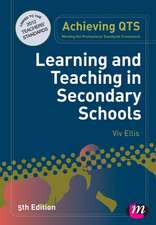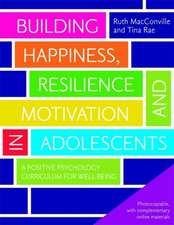How RTI Works in Secondary Schools
Autor Evelyn S. Johnson, Lori A. Smith, Monica L. Harrisen Limba Engleză Paperback – 2 noi 2009
'From research-based screenings to evidence-based interventions, the authors address the challenges specific to secondary schools and provide concise, realistic options' - Nicole Power, RTI Coordinator and Speech Language Pathologist, Bethany Public Schools, OK
Implementing Response to Intervention (RTI) in secondary schools offers many unique challenges, but this comprehensive, research-based book provides secondary school administrators with the information, resources, and guidance necessary to use RTI for the benefit of struggling adolescent learners.
Drawing on the latest research, the authors identify the current best practices for key components of RTI and demonstrate how school teams can work together to implement an assessment- and data-driven decision-making process for educators. Describing how all these elements can work together under the RTI framework, this book provides:
- Specific guidance on building leadership capacity to make RTI implementation a success
- Case studies that illustrate real middle and high school RTI models
- Instructional strategies for tiers one, two, and three
- Forms, checklists, and lists of Web and print resources
With this valuable resource, secondary school leaders can avoid potential missteps when implementing RTI and make dramatic improvements in outcomes for adolescent learners.
Preț: 279.72 lei
Nou
Puncte Express: 420
Preț estimativ în valută:
53.53€ • 55.55$ • 44.74£
53.53€ • 55.55$ • 44.74£
Carte tipărită la comandă
Livrare economică 15-29 martie
Preluare comenzi: 021 569.72.76
Specificații
ISBN-13: 9781412971003
ISBN-10: 1412971004
Pagini: 168
Dimensiuni: 178 x 254 x 10 mm
Greutate: 0.34 kg
Ediția:New.
Editura: SAGE Publications
Colecția Corwin
Locul publicării:Thousand Oaks, United States
ISBN-10: 1412971004
Pagini: 168
Dimensiuni: 178 x 254 x 10 mm
Greutate: 0.34 kg
Ediția:New.
Editura: SAGE Publications
Colecția Corwin
Locul publicării:Thousand Oaks, United States
Recenzii
"Offers all people involved in the RTI process a detailed guide of how to proactively implement RTI. The real-world examples, visuals, and lists of resources are extremely helpful when attempting to turn words into actions and determining how exactly to coordinate such a big undertaking!"
"Specific examples of RTI implementation at the middle and high school levels provide a powerful means of demonstrating the components in practice and give practitioners an extremely useful resource as they begin their implementation process."
"To successfully implement an RTI framework in schools, practitioners need very practical, hands-on guidelines and tools for making this new model of school improvement work. The complexity of this task is magnified greatly in secondary schools. This book will be a treasure for educators who want to make dramatic improvements in outcomes for adolescents – especially those who struggle in learning. It not only provides a solid foundation for guiding school improvement, but it details an array of very practical tools that can be used to implement tiered instructional options in middle and high school settings. This book will become a 'go-to resource' for teachers and administrators in middle and high school settings."
"This book is a must-read for schools wishing to begin or expand RTI to the secondary levels. From research-based screenings to evidence-based interventions, the authors address the challenges specific to secondary schools and provide concise, realistic options."
"Administrators and teachers who are concerned about making sure that each student in their program is successful will want to read this book over and over. It is a very straightforward explanation of a complex topic that is very important to making education what we want it to be for our country, our communities, and our children. This one is a keeper!"
"This book not only helps principals understand what RTI is and why we need this in our schools, it serves as a valuable resource to guide us with implementation."
"Specific examples of RTI implementation at the middle and high school levels provide a powerful means of demonstrating the components in practice and give practitioners an extremely useful resource as they begin their implementation process."
"To successfully implement an RTI framework in schools, practitioners need very practical, hands-on guidelines and tools for making this new model of school improvement work. The complexity of this task is magnified greatly in secondary schools. This book will be a treasure for educators who want to make dramatic improvements in outcomes for adolescents – especially those who struggle in learning. It not only provides a solid foundation for guiding school improvement, but it details an array of very practical tools that can be used to implement tiered instructional options in middle and high school settings. This book will become a 'go-to resource' for teachers and administrators in middle and high school settings."
"This book is a must-read for schools wishing to begin or expand RTI to the secondary levels. From research-based screenings to evidence-based interventions, the authors address the challenges specific to secondary schools and provide concise, realistic options."
"Administrators and teachers who are concerned about making sure that each student in their program is successful will want to read this book over and over. It is a very straightforward explanation of a complex topic that is very important to making education what we want it to be for our country, our communities, and our children. This one is a keeper!"
"This book not only helps principals understand what RTI is and why we need this in our schools, it serves as a valuable resource to guide us with implementation."
Cuprins
Foreword
Acknowledgments
About the Authors
1. What Is RTI?
Purpose of RTI at the Secondary Level
How RTI Works
How RTI Fits With Other Education Initiatives
Purpose of This Book
How This Book is Organized
Summary
2. Implementation and Continuous Improvement
Overview
What are the Desired Outcomes?
How is RTI Expected to Lead to These Outcomes?
What Must Happen If RTI is to Work as Expected?
What Data Can be Used to Inform Implementation Efforts?
How Do We Develop a System for Analyzing and Evaluating Data?
What Systems are Needed for continuous Improvement of the RTI Process?
Summary
3. Leadership Perspectives on RTI
Overview
What is My Role as Building Leader to Implement RTI?
How Do I Start the Process of Implementation?
What Will the Professional Development Needs Be?
RTI Focuses on Academics: What About Behavior?
What if We Identify too Many Kids in Need of Intervention?
What Resources Will I Need to Provide?
What If I Don't Get Things Right the First Time?
RTI Implementation in Practice
Summary
4. Universal Screening
Definition: What is Universal Screening?
Why is Accuracy Important?
Purpose of Screening at the Secondary Level
What Data Should Be Collected?
Implementation
Leader Tasks
Universal Screening in Practice
Summary
5. Tier 1 Instruction
Definition: What is Tier 1 Instruction?
Purpose of Tier 1 at the Secondary Level
Implementation
Tier 1 in Practice: Cheyenne Mountain Junior High School
Leader Tasks
Summary
6. Tier 2 and 3 Intervention
Definition: What is Tier 2 and Tier 3 Intervention?
Purpose of Tiers 2 and 3 at the Secondary Level
Implementation
Tier 2 in Practice: Mattawan High School
Tier 3 Implementation
Leader Tasks
Summary
7. Progress Monitoring
Definition: What is Progress Monitoring?
Purpose of Progress Monitoring at the Secondary Level
Implementation
Leader Tasks
Summary
8. Conclusion
How is RTI Expected to Lead to Improved Student Learning?
What is the Role of Leadership for Ensuring Successful RTI Implementation?
Why We are Optimistic About the Future of RTI: Two Case Stories
Summary
Appendix: RTI Implementation Checklist
Resources
References
Index
Acknowledgments
About the Authors
1. What Is RTI?
Purpose of RTI at the Secondary Level
How RTI Works
How RTI Fits With Other Education Initiatives
Purpose of This Book
How This Book is Organized
Summary
2. Implementation and Continuous Improvement
Overview
What are the Desired Outcomes?
How is RTI Expected to Lead to These Outcomes?
What Must Happen If RTI is to Work as Expected?
What Data Can be Used to Inform Implementation Efforts?
How Do We Develop a System for Analyzing and Evaluating Data?
What Systems are Needed for continuous Improvement of the RTI Process?
Summary
3. Leadership Perspectives on RTI
Overview
What is My Role as Building Leader to Implement RTI?
How Do I Start the Process of Implementation?
What Will the Professional Development Needs Be?
RTI Focuses on Academics: What About Behavior?
What if We Identify too Many Kids in Need of Intervention?
What Resources Will I Need to Provide?
What If I Don't Get Things Right the First Time?
RTI Implementation in Practice
Summary
4. Universal Screening
Definition: What is Universal Screening?
Why is Accuracy Important?
Purpose of Screening at the Secondary Level
What Data Should Be Collected?
Implementation
Leader Tasks
Universal Screening in Practice
Summary
5. Tier 1 Instruction
Definition: What is Tier 1 Instruction?
Purpose of Tier 1 at the Secondary Level
Implementation
Tier 1 in Practice: Cheyenne Mountain Junior High School
Leader Tasks
Summary
6. Tier 2 and 3 Intervention
Definition: What is Tier 2 and Tier 3 Intervention?
Purpose of Tiers 2 and 3 at the Secondary Level
Implementation
Tier 2 in Practice: Mattawan High School
Tier 3 Implementation
Leader Tasks
Summary
7. Progress Monitoring
Definition: What is Progress Monitoring?
Purpose of Progress Monitoring at the Secondary Level
Implementation
Leader Tasks
Summary
8. Conclusion
How is RTI Expected to Lead to Improved Student Learning?
What is the Role of Leadership for Ensuring Successful RTI Implementation?
Why We are Optimistic About the Future of RTI: Two Case Stories
Summary
Appendix: RTI Implementation Checklist
Resources
References
Index
Notă biografică
Evelyn S. Johnson is an associate professor of special education at Boise State University and the coauthor of RTI: A Practitioner¿s Guide to Implementing Response to Intervention. She began her career in Washington in 1994 as a special education teacher, and then at the University of Washington, Seattle, where her research focused on the inclusion of students with disabilities in accountability systems. Johnson¿s work on assessment for students with disabilities has included research on accommodations and alternate assessments, as well as research on screening for reading problems. Prior to joining the faculty at BSU, she worked as a research associate for the National Research Center on Learning Disabilities (NRCLD), where she developed numerous technical assistance products to assist state and local educational agencies on RTI and learning disability identification¿related issues. Currently, her research focuses on RTI implementation at the secondary levels.
Descriere
Featuring real-world examples and instructional strategies for secondary schools, this research-based book provides the guidance secondary administrators need to implement RTI and improve student outcomes.









